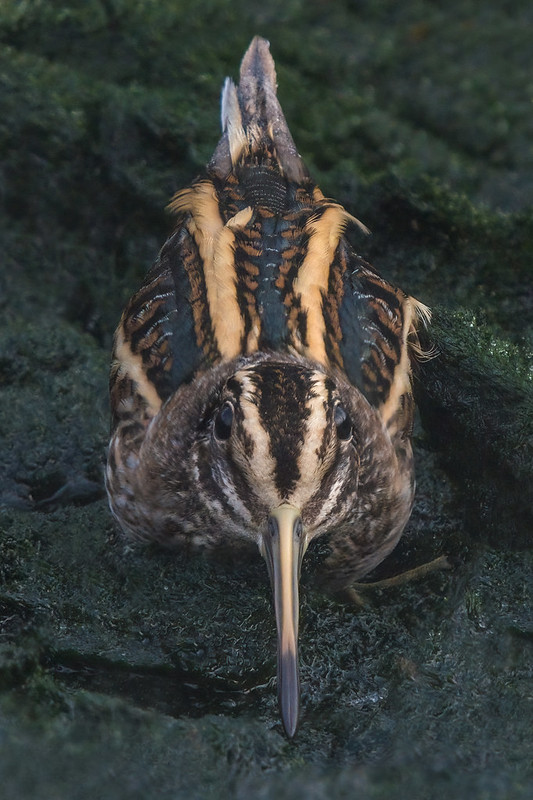
Tim writes: here is my best Jack Snipe photograph to date. I spotted this one sat right in the open and it froze completely while I watched it for about 20 minutes. I crept as close as I dared then squatted to get a low camera angle and took a series of shots. I then withdrew slowly leaving the Jack Snipe without it flushing. In all that time it never moved a muscle. It didn’t even blink.
I loved the way that its diagnostic dark crown aligned with the dark centre of its back, and the golden stripes on the sides of its head lined up with the golden back stripes. If I hadn’t been carefully searching for Jack Snipe I’d have probably passed this off as some rush stems. You can also see one of its feet.
In my experience, Jack Snipe is one of the most difficult of British birds to photograph. They are not particularly rare as winter visitors, but they are usually extraordinarily elusive. They have never bred in Britain though occasionally their display flights have been seen and heard, which to me sounds like a tiny horse galloping on an icy lake. Listen for yourself, here it is on Xeno-canto: www.xeno-canto.org/492150 .
Nobody knows for sure whether the galloping horse call is produced vocally or mechanically (according to BWP volume 3, published back in 1983). Common Snipe (and Wilson’s Snipe) produce their bleating vocalisations mechanically as air rushes past their outer tail feathers. BWP says that Jack Snipes are reported to occasionally produce the galloping call from the ground, which if correct, makes it highly likely it is produced vocally.
When they first arrive in Britain from Scandinavia in autumn they sometimes sit in the open in front of bird hides, but after a few days they go into stealth mode and simply disappear. Keith Vinicombe in Bird Identification wrote “Jack Snipe is a peculiarly secretive bird, rarely straying from well-vegetated soggy places. Unlike Snipe it avoids open mud at all costs and does not walk into open water to feed. Generally speaking, the only chance of seeing one on the ground is from a well-situated bird hide.” But their elusiveness also makes for notoriously unreliable population estimates so nobody really knows how many visit Britain each winter. From my own personal experience I see well over a hundred Common Snipe for every Jack Snipe during winter, but Common Snipe fly off at the slightest disturbance making them much easier to see. Jack Snipe usually sit tight among vegetation in swampy marshes, usually only flying when you almost tread on them.
See also Gordon Yates’s photograph – click here.
[registration_form]
Wonderful Tim, really just WOW!
I think i have mentioned before, so briefly, ….